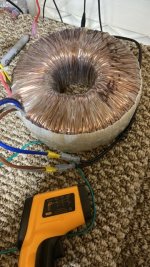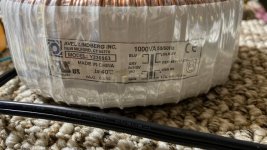I bought an Avel Lindberg 1kva Toroid 15+ years ago. It warmed up when connected to the mains... got to over 38C with no load. They sent me a replacement... but this guy is still with me. They didnt want it back.
Question I have is... how warm can it get and be considered safe? 40c? 50c? 80c? Measured on the outside? I really don't want to throw it away...
Question I have is... how warm can it get and be considered safe? 40c? 50c? 80c? Measured on the outside? I really don't want to throw it away...
Just as a test I´d plug it into mains through a fuse, just in case and leave it plugged in for a few hours, say 6 to 8 hours.
"It reaches 38C" is meaningless, what is the ambient temperature?
The real parameter showing excessive losses or not is how much does it rise above it, not just a single unreferenced number.
Also: do you have the replacement they sent you?
Any other significant power transformer, toroid or not?
Say 300VA or larger, a small one won´t be much reference.
Do the same test, how much do THESE rise above ambient temperature?
Post results.
"It reaches 38C" is meaningless, what is the ambient temperature?
The real parameter showing excessive losses or not is how much does it rise above it, not just a single unreferenced number.
Also: do you have the replacement they sent you?
Any other significant power transformer, toroid or not?
Say 300VA or larger, a small one won´t be much reference.
Do the same test, how much do THESE rise above ambient temperature?
Post results.
Ambient 23c. The Toroid is 1000va with 45-0-45 secondaries. Other 1kva Avels never heated up. I have a bunch of other large toroids... they dont heat up.
this one goes up 10-12c above ambient in 15 minutes. I can keep testing... I just need to know how hot should it get before I pull the plug... this was the original question.
this one goes up 10-12c above ambient in 15 minutes. I can keep testing... I just need to know how hot should it get before I pull the plug... this was the original question.
Sounds like its got shorted turns, so will get hotter and hotter and may char and short out even more, perhaps shorting primary to secondary in extremis. Consider it faulty.
For such a large transformer, especially a toroidal a 15°C rise is abnormal.
Is it really problematic? If it is caused by shorted primary turns (certainly adjacent) , yes: it will degrade further over time and end in a catastrophic failure.
If it caused by a poorly insulated magnetic tape of the core, the risk of catastrophic failure is low.
If the magnetic material has a quality problem, like a thermal treatment gone wrong, it will remain stable, and if you can tolerate the small temp increase, it is perfectly usable.
You can measure the no-load primary current: if the VA product is much larger than the losses (you can estimate them by the heating effect, or measure them using a kill-a-watt style meter), it means that the problem is the reactive current caused by the magnetic material.
If it is close to the losses, it means that you have a short somewhere, in the copper or the magnetic circuit
Is it really problematic? If it is caused by shorted primary turns (certainly adjacent) , yes: it will degrade further over time and end in a catastrophic failure.
If it caused by a poorly insulated magnetic tape of the core, the risk of catastrophic failure is low.
If the magnetic material has a quality problem, like a thermal treatment gone wrong, it will remain stable, and if you can tolerate the small temp increase, it is perfectly usable.
You can measure the no-load primary current: if the VA product is much larger than the losses (you can estimate them by the heating effect, or measure them using a kill-a-watt style meter), it means that the problem is the reactive current caused by the magnetic material.
If it is close to the losses, it means that you have a short somewhere, in the copper or the magnetic circuit
Thanks. Would one turn shorted increase consumption at mains? Do you guys assume this is in the primaries? Since secondaries are not connected to a load.
Last edited:
Thanks. Would one turn shorted increase consumption at mains? Do you guys assume this is in the primaries? Since secondaries are not connected to a load.
One shorted turn would trip the circuit breaker, and that would also cause a localized heat source if it didnt, your transformer has been cheaply made, it is running in a high saturation regime, or you have DC in mains making it to saturate early
Mains is same for all other trafos. They are all fine, only this one heats up.
I also tested it through a 100 watt bulb... it does not light up, even dimly. Meaning there is little to no load.
I also tested it through a 100 watt bulb... it does not light up, even dimly. Meaning there is little to no load.
Last edited:
a one turn short in the primary could have this effect.Thanks. Would one turn shorted increase consumption at mains? Do you guys assume this is in the primaries? Since secondaries are not connected to a load.
In the secondary, even in single turn short would cause a huge current consumption, because of the thicker wire gauge.
If the bulb doesn't light, it probably means that the reactive current is not involved, but measurements would be better
You can try to leave it connected overnight, outside of your house, placed far away from any flammable material, on a concrete or pavement floor, with a 5A fuse in the circuit.
One would expect a shorted turn to cause a dim bulb limiter to glow orange or at least get warm to the touch. You can’t have heat in the windings or core without current flow. Does it make a mechanical hum or buzz that is uncharacteristic? If so that would point to a lossy core. Is it a dual (bifilar) primary? If so does the problem go away if only one of the windings is connected (with the other floating)? One could be shorted or even the wrong # of turns.
I've got an idea . Test each primary seperately through bulb tester and voltage drop on lamp, or directly measure current , they must be identical at same mains voltage. If currents will be different , problem with primary , if identical ,problem may be with secondary . If one primary has less turns ,you may try add few turns and connect them in series with that primary .
Thanks for this tip... and my profound apologies to everyone...
There WAS a current draw on the Prims using the bulb.
Now given the prims are dual 115v and I had them in parallel, I never tested them separately. Here's what I found.
Separating them and feeding 120v to each gave no power draw on the bulb, even the slightest, which was different form when they were paralleled...
So I measured the voltage on the secondaries, when powered by Prim 1, I get 40-0-40 on the secs.
When powered by the Prim 2, I get 43-0-43 !!!
So it seems one of the prims has a few extra turns.
So the question I now have is... how can I salvage this toroid, I am sure if I power it with only one Prim, it will not heat up (still to be tested) but what does that mean, is the 1000va trafo now a 500va trafo?
There WAS a current draw on the Prims using the bulb.
Now given the prims are dual 115v and I had them in parallel, I never tested them separately. Here's what I found.
Separating them and feeding 120v to each gave no power draw on the bulb, even the slightest, which was different form when they were paralleled...
So I measured the voltage on the secondaries, when powered by Prim 1, I get 40-0-40 on the secs.
When powered by the Prim 2, I get 43-0-43 !!!
So it seems one of the prims has a few extra turns.
So the question I now have is... how can I salvage this toroid, I am sure if I power it with only one Prim, it will not heat up (still to be tested) but what does that mean, is the 1000va trafo now a 500va trafo?
Yes ,if you use only one primary ,toroid will have half power , only one part of primary can't handle all the power . You can use this toroid ,but you need to add some winding to that primary ,which gives 43 volts on secondary. Need to determine two things now : polarity of those additional winding ,and turns count . With correct polarity determining is easy job ,if polarity is correct , secondary voltage will decrease ,and primary current decrease too , you need to make them equal to another primary .I would recommend to measure voltage difference ,what voltage comes out of another primary - lets say you plug in primary1 (which gives secondary 40V) to your mains 120v , and measure voltage on primary2, lets say it will be 115V , so difference is 5V ,now try to add lets say 10 turns of any isolated wire ,connect it in series with primary2 , try different polarity , and your goal is to reach the same 120v exactly by changing number of turns . Because of no load in this test , wire diameter no matter ,you can use even isolated wire from cable . If you get similar voltage ,you can try to connect together begining (marked with dot) of both primaries 1 and 2 (with added winding in series),primary 1 end to mains, but don't connect end of primary2 to mains ,just measure voltage difference by connecting your DMM to primary1 end- primary2 end . If you get proper number of turns , this must be ideally zero ,maybe few millivolts . Sorry for my bad english if i didn't explained it in easy way ,i will paint schematic with what i mean in that case .
Great, Thanks Ximikas!!
Are you suggesting I wind this additional Primary wire on top of the finished Toroid, or will I need to remove all secondaries first?
Also, If I use just one Primary, is the power 50% because of current limitation or flux generated or heat generated? and how does this impact its use in a power amplifier? ie whose draw is intermittent.
Are you suggesting I wind this additional Primary wire on top of the finished Toroid, or will I need to remove all secondaries first?
Also, If I use just one Primary, is the power 50% because of current limitation or flux generated or heat generated? and how does this impact its use in a power amplifier? ie whose draw is intermittent.
- Home
- Amplifiers
- Power Supplies
- Toroid Warming up....

